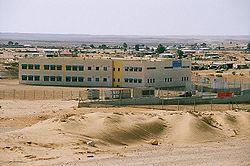
Hura, or Houra is a Bedouin town in the Southern District of Israel. It is located near Beersheba and beside the town Meitar. The town was established in 1989 as a part of solution offered by the state for the consolidation of Negev Bedouin population, and was declared a local council in 1996. In 2022 it had a population of 24,822.
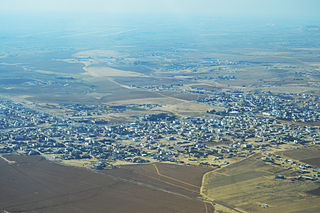
Kuseife or Kseifa is a Bedouin town in the Southern District of Israel. Kuseife was founded in 1982 as part of a government project to settle Bedouins in permanent settlements. In 1996 it was declared a local council, and in 2022 it had a population of 23,990.

Shaqib al-Salam or Segev Shalom and also known as Shqeb as-Salam, is a Bedouin town and a local council in the Southern District of Israel, southeast of Beersheba. In 2022 it had a population of 12,540.
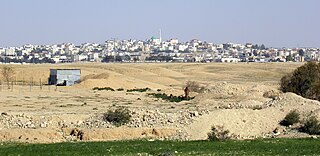
Ar'arat an-Naqab or Ar'ara BaNegev, previously called Aroer, is a Bedouin town in the Southern District of Israel. Its name stands for "the juniper tree in Negev". It is situated not far from the archaeological site of Aroer.

Tel Sheva or Tel as-Sabi is a Bedouin town in the Southern District of Israel, bordering the city of Beersheba. In 2022 it had a population of 22,849.

Ramat HaNegev Regional Council is a regional council in the Negev desert in Israel. With around 8,000 residents spread across 20 villages, the council is geographically the largest in Israel, covering more than 20% of Israel's landmass. The council's headquarters are located on Highway 40 between Mashabei Sadeh and Tlalim.
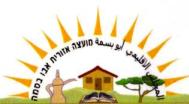
Abu Basma Regional Council was a regional council operating in 2003-2012 and covering several Bedouin villages in the northwestern Negev desert of Israel. Following the Minister of Interior decision on November 5, 2012, it was split into two newly created bodies: Neve Midbar Regional Council and al-Kasom Regional Council.

The Negev Bedouin are traditionally pastoral nomadic Arab tribes (Bedouin), while some are of Sub-Saharan African descent, who until the later part of the 19th century would wander between Hijaz in the east and the Sinai Peninsula in the west. Today most live in the Negev region of Israel, while a minority who were expelled during the 1948 war live in Palestine. The Bedouin tribes adhere to Islam and most are Israeli citizens. Some Bedouins voluntarily serve in the IDF.

Umm Batin is a Bedouin village in southern Israel. Located in the northern Negev desert, 12 km northeast of Beersheba and adjacent to the highway 60, it falls under the jurisdiction of al-Kasom Regional Council. In 2022 it had a population of 4,981.

Qasr al-Sir is a Bedouin village in the Negev desert in southern Israel, adjacent to highway 25. The village covers 4,776 dunams. Located three kilometres west of Dimona, it falls under the jurisdiction of Neve Midbar Regional Council. In 2022 it had a population of 2,867.

Tirabin al-Sana, also Tarabin, is a Bedouin village in the Negev desert in southern Israel. The village was built for the Tarabin tribe. Located near Rahat and Mishmar HaNegev, it falls under the jurisdiction of al-Kasom Regional Council. In 2022 it had a population of 1,294.

The three lookouts were three Jewish settlements built in the Negev desert in 1943 on land owned by the Jewish National Fund. The goal was securing the land and assessing its feasibility for agriculture. The founding was preceded by a complex land purchase procedure, as the British authorities had practically prohibited Jewish land acquisition in the area following the costly Arab Revolt and the subsequent White Paper of 1939.

Unrecognized Bedouin villages in Israel are rural Bedouin communities in the Negev and the Galilee which the Israeli government does not recognize as legal. They are often referred to as "unrecognized villages".
The Regional Council of Unrecognized Villages of Negev (RCUV) is a political advocacy group that was established in 1997. It represents the interests of the Bedouin population living in the unrecognized dispersed communities in the Negev Desert in southern Israel.
The Abu Alkian is a tribe living in the Negev desert in southern Israel.
Neve Midbar Regional Council is one of two regional councils formed as a result of a split of Abu Basma Regional Council on November 5, 2012. This regional council is situated in the northwestern Negev desert of Israel and populated by the Negev Bedouin.
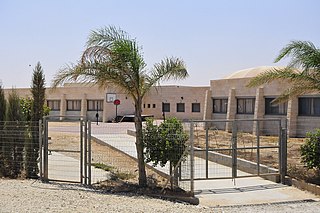
al-Kasom Regional Council is one of two Negev Bedouin regional councils formed as a result of the split of the Abu Basma Regional Council on November 5, 2012. Al-Kasom regional council is in the northwestern Negev desert of Israel.
Abu Talul is a Bedouin township in southern Israel. Located in the Negev desert around ten kilometres east of Beersheba and to the south of highway 25, it falls under the jurisdiction of Neve Midbar Regional Council. In 2022 it had a population of 2,492.

Umm al-Hiran was a Bedouin village settled by Arab-Israeli citizens of the Abu Alkian tribe located in the Wadi Atir area of the Negev desert in southern Israel. Located near Hura, the village was established in 1956 and is one of 46 unrecognized Bedouin villages in Israel. In November 2024 the Government of Israel demolished the village as part of its plan of replacing it with a Jewish settlement called Dror, which has been described as "ethnic cleansing" and "systematic population replacement program" by the Regional Council for Unrecognized Villages.
Regavim (רגבים) is a pro-settler Israeli NGO that monitors and pursues legal action in the Israeli court system against any construction lacking Israeli permits undertaken by Palestinians or Bedouins in Israel and in the West Bank. It describes itself as "a public movement dedicated to the protection of Israel’s national lands and resources" and aims to "[restore] the Zionist vision to its primary role in the Israeli policy process".
